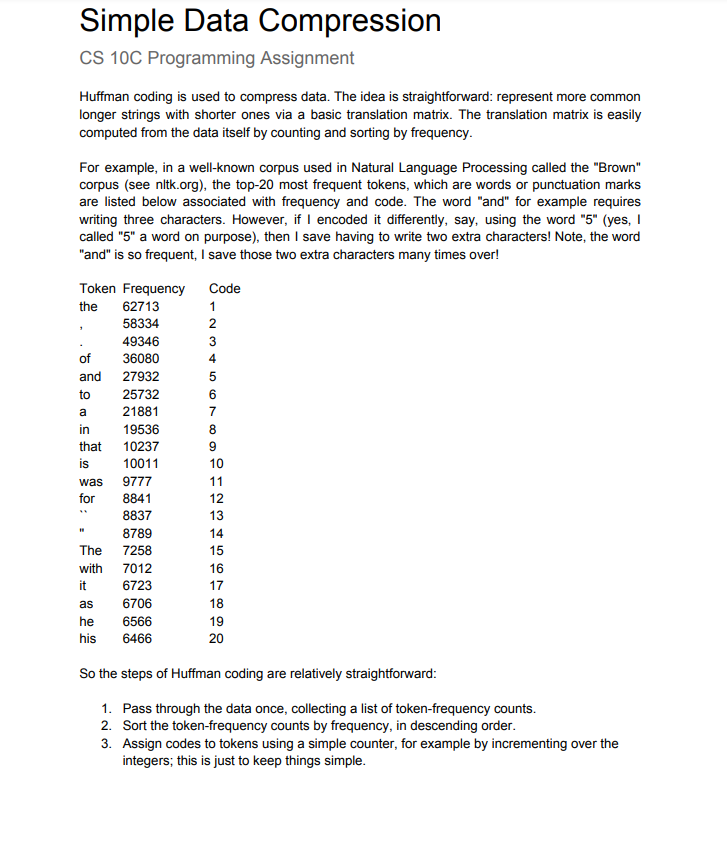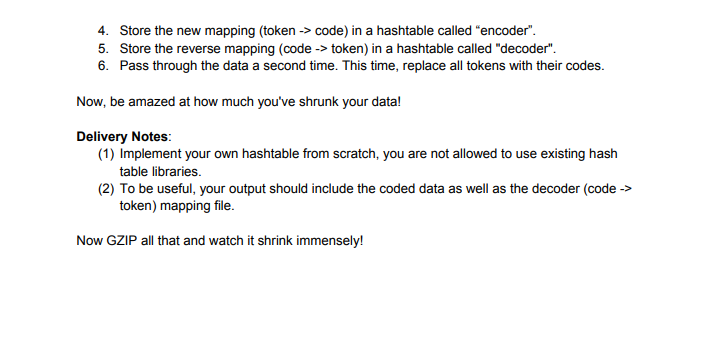Simple Data Compression CS 10C Programming Assignment Huffman coding is used to compress data. The idea is straightforward: represent more common longer strings with shorter ones via a basic translation matrix. The translation matrix is easily computed from the data itself by counting and sorting by frequency. For example, in a well-known corpus used in Natural Language Processing called the "Brown" corpus (see nitk.org), the top-20 most frequent tokens, which are words or punctuation marks are listed below associated with frequency and code. The word "and" for example requires writing three characters. However, if I encoded it differently, say, using the word "5" (yes, I called "5" a word on purpose), then I save having to write two extra characters! Note, the word "and" is so frequent, I save those two extra characters many times over! Token Frequency Code the 62713 58334 2 49346 of 36080 4 and 27932 5 25732 21881 to 6 a 7 in 19536 8 that 10237 is 10011 10 was 9777 11 for 8841 12 8837 13 8789 14 The 7258 15 with 7012 16 it 6723 17 as 6706 18 6566 6466 he 19 his 20 So the steps of Huffman coding are relatively straightforward: 1. Pass through the data once, collecting a list of token-frequency counts. 2. Sort the token-frequency counts by frequency, in descending order. 3. Assign codes to tokens using a simple counter, for example by incrementing over the integers; this is just to keep things simple.
Simple Data Compression CS 10C Programming Assignment Huffman coding is used to compress data. The idea is straightforward: represent more common longer strings with shorter ones via a basic translation matrix. The translation matrix is easily computed from the data itself by counting and sorting by frequency. For example, in a well-known corpus used in Natural Language Processing called the "Brown" corpus (see nitk.org), the top-20 most frequent tokens, which are words or punctuation marks are listed below associated with frequency and code. The word "and" for example requires writing three characters. However, if I encoded it differently, say, using the word "5" (yes, I called "5" a word on purpose), then I save having to write two extra characters! Note, the word "and" is so frequent, I save those two extra characters many times over! Token Frequency Code the 62713 58334 2 49346 of 36080 4 and 27932 5 25732 21881 to 6 a 7 in 19536 8 that 10237 is 10011 10 was 9777 11 for 8841 12 8837 13 8789 14 The 7258 15 with 7012 16 it 6723 17 as 6706 18 6566 6466 he 19 his 20 So the steps of Huffman coding are relatively straightforward: 1. Pass through the data once, collecting a list of token-frequency counts. 2. Sort the token-frequency counts by frequency, in descending order. 3. Assign codes to tokens using a simple counter, for example by incrementing over the integers; this is just to keep things simple.
Computer Networking: A Top-Down Approach (7th Edition)
7th Edition
ISBN:9780133594140
Author:James Kurose, Keith Ross
Publisher:James Kurose, Keith Ross
Chapter1: Computer Networks And The Internet
Section: Chapter Questions
Problem R1RQ: What is the difference between a host and an end system? List several different types of end...
Related questions
Question
I need help urgently to be able to understand how to do this

Transcribed Image Text:Simple Data Compression
CS 10C Programming Assignment
Huffman coding is used to compress data. The idea is straightforward: represent more common
longer strings with shorter ones via a basic translation matrix. The translation matrix is easily
computed from the data itself by counting and sorting by frequency.
For example, in a well-known corpus used in Natural Language Processing called the "Brown"
corpus (see nltk.org), the top-20 most frequent tokens, which are words or punctuation marks
are listed below associated with frequency and code. The word "and" for example requires
writing three characters. However, if I encoded it differently, say, using the word "5" (yes, I
called "5" a word on purpose), then I save having to write two extra characters! Note, the word
"and" is so frequent, I save those two extra characters many times over!
Token Frequency
Code
the
62713
1
58334
2
49346
3
of
36080
4
and
27932
5
to
25732
6
a
21881
7
in
19536
that
10237
9
is
10011
10
was
9777
11
for
8841
12
8837
13
8789
14
The 7258
15
with 7012
16
6723
6706
it
17
as
18
he
6566
19
his
6466
20
So the steps of Huffman coding are relatively straightforward:
1. Pass through the data once, collecting a list of token-frequency counts.
2. Sort the token-frequency counts by frequency, in descending order.
3. Assign codes to tokens using a simple counter, for example by incrementing over the
integers; this is just to keep things simple.

Transcribed Image Text:4. Store the new mapping (token -> code) in a hashtable called "encoder".
5. Store the reverse mapping (code -> token) in a hashtable called "decoder".
6. Pass through the data a second time. This time, replace all tokens with their codes.
Now, be amazed at how much you've shrunk your data!
Delivery Notes:
(1) Implement your own hashtable from scratch, you are not allowed to use existing hash
table libraries.
(2) To be useful, your output should include the coded data as well as the decoder (code ->
token) mapping file.
Now GZIP all that and watch it shrink immensely!
Expert Solution
This question has been solved!
Explore an expertly crafted, step-by-step solution for a thorough understanding of key concepts.
This is a popular solution!
Trending now
This is a popular solution!
Step by step
Solved in 2 steps

Follow-up Questions
Read through expert solutions to related follow-up questions below.
Recommended textbooks for you

Computer Networking: A Top-Down Approach (7th Edi…
Computer Engineering
ISBN:
9780133594140
Author:
James Kurose, Keith Ross
Publisher:
PEARSON

Computer Organization and Design MIPS Edition, Fi…
Computer Engineering
ISBN:
9780124077263
Author:
David A. Patterson, John L. Hennessy
Publisher:
Elsevier Science

Network+ Guide to Networks (MindTap Course List)
Computer Engineering
ISBN:
9781337569330
Author:
Jill West, Tamara Dean, Jean Andrews
Publisher:
Cengage Learning

Computer Networking: A Top-Down Approach (7th Edi…
Computer Engineering
ISBN:
9780133594140
Author:
James Kurose, Keith Ross
Publisher:
PEARSON

Computer Organization and Design MIPS Edition, Fi…
Computer Engineering
ISBN:
9780124077263
Author:
David A. Patterson, John L. Hennessy
Publisher:
Elsevier Science

Network+ Guide to Networks (MindTap Course List)
Computer Engineering
ISBN:
9781337569330
Author:
Jill West, Tamara Dean, Jean Andrews
Publisher:
Cengage Learning

Concepts of Database Management
Computer Engineering
ISBN:
9781337093422
Author:
Joy L. Starks, Philip J. Pratt, Mary Z. Last
Publisher:
Cengage Learning

Prelude to Programming
Computer Engineering
ISBN:
9780133750423
Author:
VENIT, Stewart
Publisher:
Pearson Education

Sc Business Data Communications and Networking, T…
Computer Engineering
ISBN:
9781119368830
Author:
FITZGERALD
Publisher:
WILEY